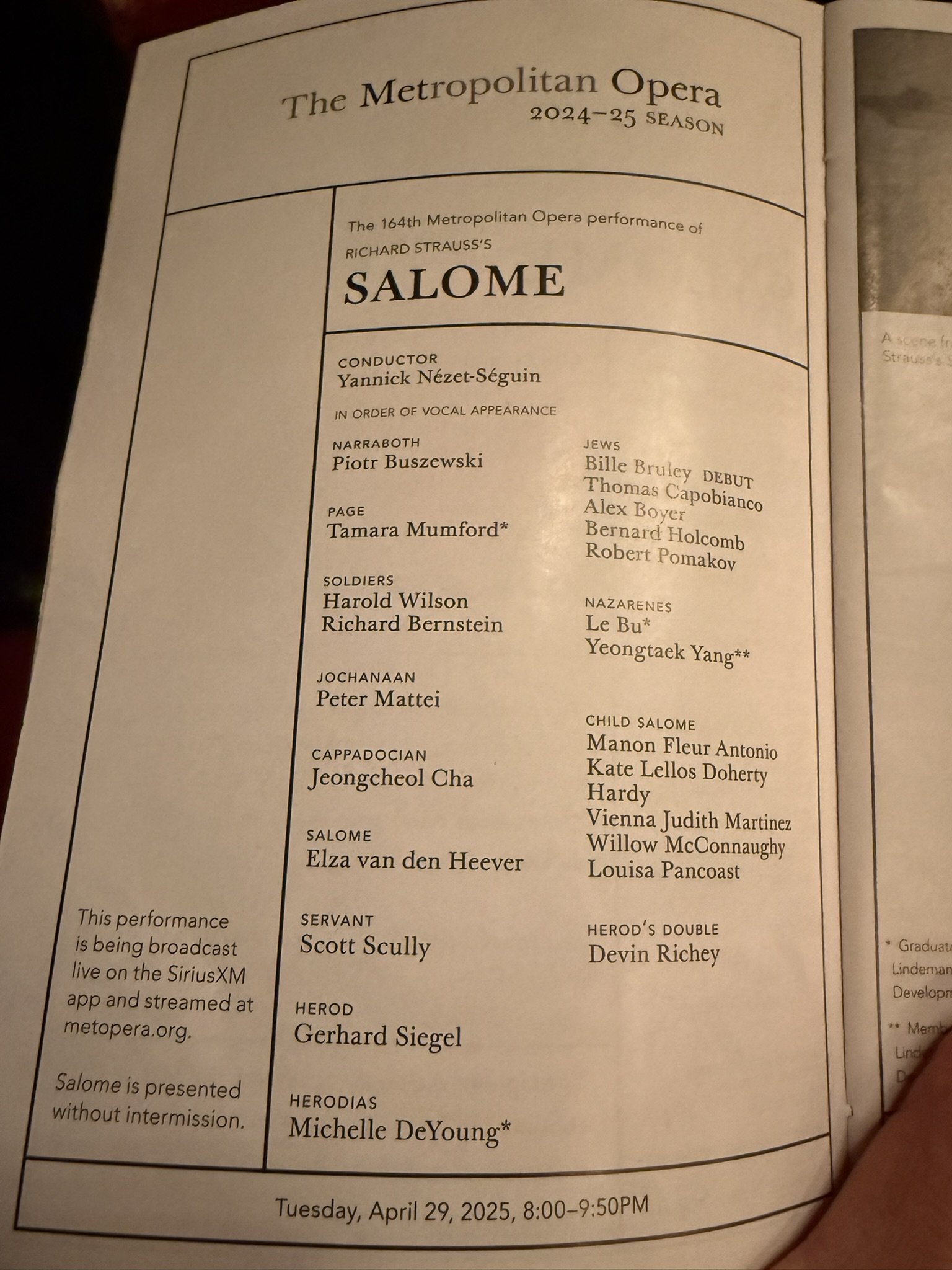Claus Guth's new production of Strauss' opera Salome opened at the Metropolitan Opera on April 29th. The opera, which premiered in Dresden in 1905, combines Wagner's grandeur and verismo's power of the moment. The themes of perverse sexual desire, dementia, necrophilia, and religious inspiration are intertwined. Mahler, the director of the Vienna Opera at the time, was scheduled to conduct the opera, but the plan was canceled due to censorship. Strauss called the singer who sang Salome at the time "a 16-year-old princess with the voice of Isolde," and he immediately recalled the music when he saw the opening lyrics, "How beautiful Salome is tonight!" The clarinet rises smoothly in Salome's theme, and when Jochanaan appears on the basement, the orchestra's sunny brilliance is reminiscent of Zarathustra, and the trumpets sound brilliantly. The eerie sound of the double bass surrounds Salome as she waits for Jochanaan's beheading, and Herod's mentally confused dynamism. Various scenes and characters are depicted with a delicate color composition full of transparency. In Guth's production, the curtain opens with the tinkle the music box, and a girl playing with a doll suddenly becomes angry and smashes the doll to the ground. The Times' review described it as "childhood, dance and violence." In this production, there are 7 Salome, ages from kindergarten to 16 years old. The music, which is based on the theme of the girl's persistent abnormal sexuality, also gives a different impression in this production. The doubles play out the psychological background of how her obsession with kissing the man she loves turns into murderous intent. In "Dance of the Seven Veils," seven Salomes tell the story of her years of abuse by King Herod. In the final monologue, when Salome obtains the head of Jochanaan, kisses it, and sings, the madness of desire that reaches ecstasy is also shown, as is the integration of the divided self surrounded by the doubles. Herod orders Salome's murder, but she disappears to the back of the stage. Elsa, singing Salome, sounds more like a recollection of her past self and compassion for her doubles, rather than a pure sexual pervert. Salome's experience while knowing the logical background is a sensation unique to the 21st century.
クラウス・グードの新演出のシュトラウスのオペラ、サロメが4月29日にメトロポリタン歌劇場で始まった。ワーナーの壮大さとヴェリズモの力強さが融合したこのオペラは、1905年にドレスデンで初演された。変態性欲、痴呆、死体性愛、宗教的霊感といったテーマが絡み合っている。当時ウィーン宮廷歌劇場の監督を務めていたマーラーは指揮を予定していたが、検閲により中止となった。シュトラウスは当時『サロメ』を歌った歌手を「イゾルデの声を持つ16歳の王女」と呼び、「今夜のサロメはなんと美しいことか!」という冒頭の歌詞に、シュトラウスはすぐに音楽を思い起こしたそうだ。サロメのテーマではクラリネットが滑らかに立ち上がり、ヨカナーンが地下室から現れる場面では、オーケストラの陽光のような輝きが『ツァラトゥストラ』を彷彿とさせ、トランペットが燦然と鳴る。ヨカナーンの斬首を待つサロメを包むコントラバスの不気味な音色、そしてヘロデの精神が錯乱した躍動感。透明感あふれる繊細な色彩構成で、様々な場面や登場人物が描かれる。グースの演出では、オルゴールの音で幕が開き、人形で遊んでいた少女が突然怒り出し、人形を地面に叩きつける。タイムズ紙の批評には「幼少期、ダンス、そして暴力」とある。この演出では幼稚園から16歳まで歳を重ねていくサロメが登場する。少女の執拗な異常性愛をテーマにした音楽もまた、この演出により全く異なる印象を与える。分身たちは、愛する男へのキスへの執着が殺意へと変わっていく心理的背景を演じる。「七つのヴェールの踊り」では、七人のサロメがヘロデ王による長年の虐待の物語を語る。最後のモノローグ、サロメがヨカナーンの首を手に入れ接吻し歌う場面では、エクスタシーに達する欲望の狂気も、分身に囲まれ分裂していた自己の統合が示される。ヘロデはサロメの殺害を命じるが、彼女は舞台奥へと姿を消す。サロメを歌うエルザは、純粋な性的倒錯者というよりは、過去の自分を思い出し分身を思いやるかのように聴こえる。心理背景を知りながら体験するサロメは21世紀ならではのセンセーションだ。変態親父ヘロデが16歳の義理の娘に果物を齧って残りは全部食べるくだりと、サロメがヨカナーンの首に熟した果物に食い付くようにというくだりの音楽が一緒で最高に気持ち悪い。こういった細部のシュトラウスの技巧を視聴者に魅せる演出ではない。
Richard Strauss
Salome Site link
Conductor
Yannick Nézet-Séguin
Production
Claus Guth DEBUT
Set designer
Etienne Pluss DEBUT
Costume designer
Ursula Kudrna DEBUT
lighting designer
Olaf Freese DEBUT
Projection designer
Rocafilm/
Roland Horvath
Choreographer
Sommer Ulrickson
DEBUT
Dramaturg
Yvonne Gebauer
DEBUT
Narraboth
Piotr Buszewski
Page
Tamara Mumford*
Joldiers
Harold Wilson
Richard Bernstein
Jochanaan
Peter Mattei
Cappadocian
Jeongcheol Cha
Salome
Elza van den Heever
Servant
Scott Scully
Herod
Gerhard Siegel
Herodias
Michelle DeYoung*
Jews
Bille Bruley DEBUT
Thomas Capobianco
Alex Boyer
Bernard Holcomb
Robert Pomakov
nazarenes
Le Bu*
Yeongtaek Yang**
child salome
Manon Fleur Antonio
Kate Lellos Doherty
Hardy
Vienna Judith Martinez
Willow McConnaughy
Louisa Pancoast
herod’s double
Devin Richey


